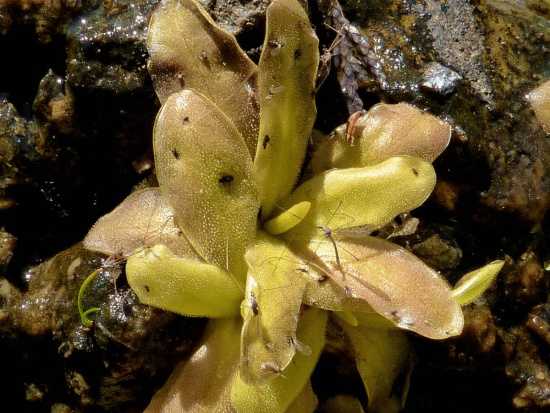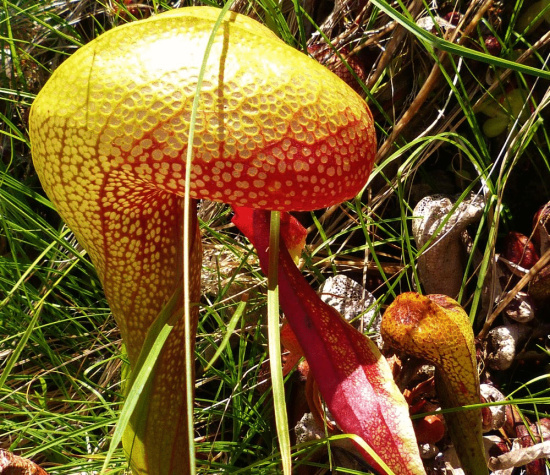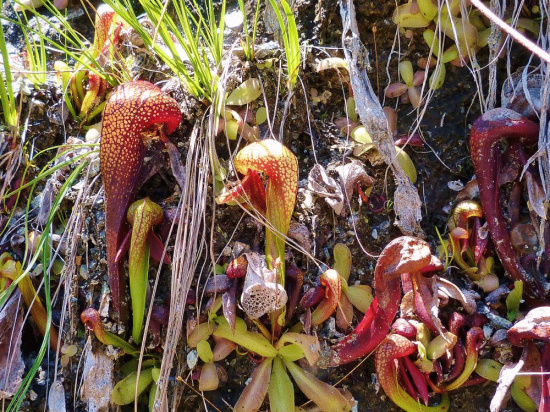Flowering Darlingtonia californica.
For the amateur naturalist, Del Norte County roadsides are a goldmine for exploration.
Why? Serpentine.
Serpentine soil is a shiny green rock that originated in the earth’s mantle. It’s a silicon-poor type of rock known as ultramafic rock, deposited in this area when oceanic and continental crust collided, starting about 440 million years ago. The crustal movement helped to deform and fracture the rock, allowing water to flow and hydrate it, creating serpentine.
Weather and erosion events over years have created this particular soil, the largest abundance being found in the Klamath-Siskiyou Mountains, which includes areas of Del Norte County. Serpentine soils are low in nitrogen and calcium, high in magnesium and contain heavy metals, conditions that make life challenging for those who take up root. The small number of species that have adapted to these conditions have acquired cutthroat means of survival.
South Fork Road winds above the Smith River and leads into the heart of Six Rivers National Forest. The roar of the river below teases us to take a dip on this hot June day, but the big payoff is around a sharp turn, growing off the side of a rocky seep. With sweat and sunscreen dripping down our faces, we investigate this roadside Darlingtonia seep.
Also known as the “Cobra Lily” or “California Pitcherplant,” Darlingtonia californica has come up with a deadly solution to the relative lack of nitrogen: It takes what it needs by trapping and digesting insects inside of its tubular leaves. According to the Botanical Society of America, every part of this plant has a purpose: Its maturing red color attracts potential prey, translucent areas in the leaves fool insects into flying in the wrong direction, and its waxy texture prevents insects from gaining traction, sending them towards the liquid-filled tube to drown and be digested.
Growing alongside the Darlingtonia at this particular seep is another voracious beauty with its own way of acquiring desired flesh: the California Butterwort (Pinguicula macroceras). Butterworts are incredibly complex plants that have specific growth requirements, even more specific than just serpentine soil alone: They thrive on acidic conditions and a year-round source of water.
In fact, water is essential in luring in its prey. Its glandular leaves always look wet, which may help attract insects who think they’ve stumbled on water or a source of nectar, only to find they can’t move once they land. Its leaves act like natural flypaper, and after its intended target is immobilized, then comes digestion — incredibly slow digestion. Be grateful you’re not a fly.
It’s a recipe: mix an unusual soil type with the perfect climate, and what you have is Del Norte County; home to ideal conditions for adaptation, and the creation of new(and bizarre) plant species, some found nowhere else. Being a brutal carnivore is just one of several strategies these sedentary marvels have undertaken to meet their nutritional requirements in this harsh terrain.
Munching on kettle corn and back in our air-conditioned car, I can’t help but be impressed at these plants growing next to this roadside, rare beauties hiding in plain side. The day isn’t even half over for us adventurers, and there are still many more roads to drive down and discover.
Darlingtonia and Butterworts in coexistence.
PREVIOUSLY: Discoveries in Del Norte County’s Wilderness Part One.




CLICK TO MANAGE